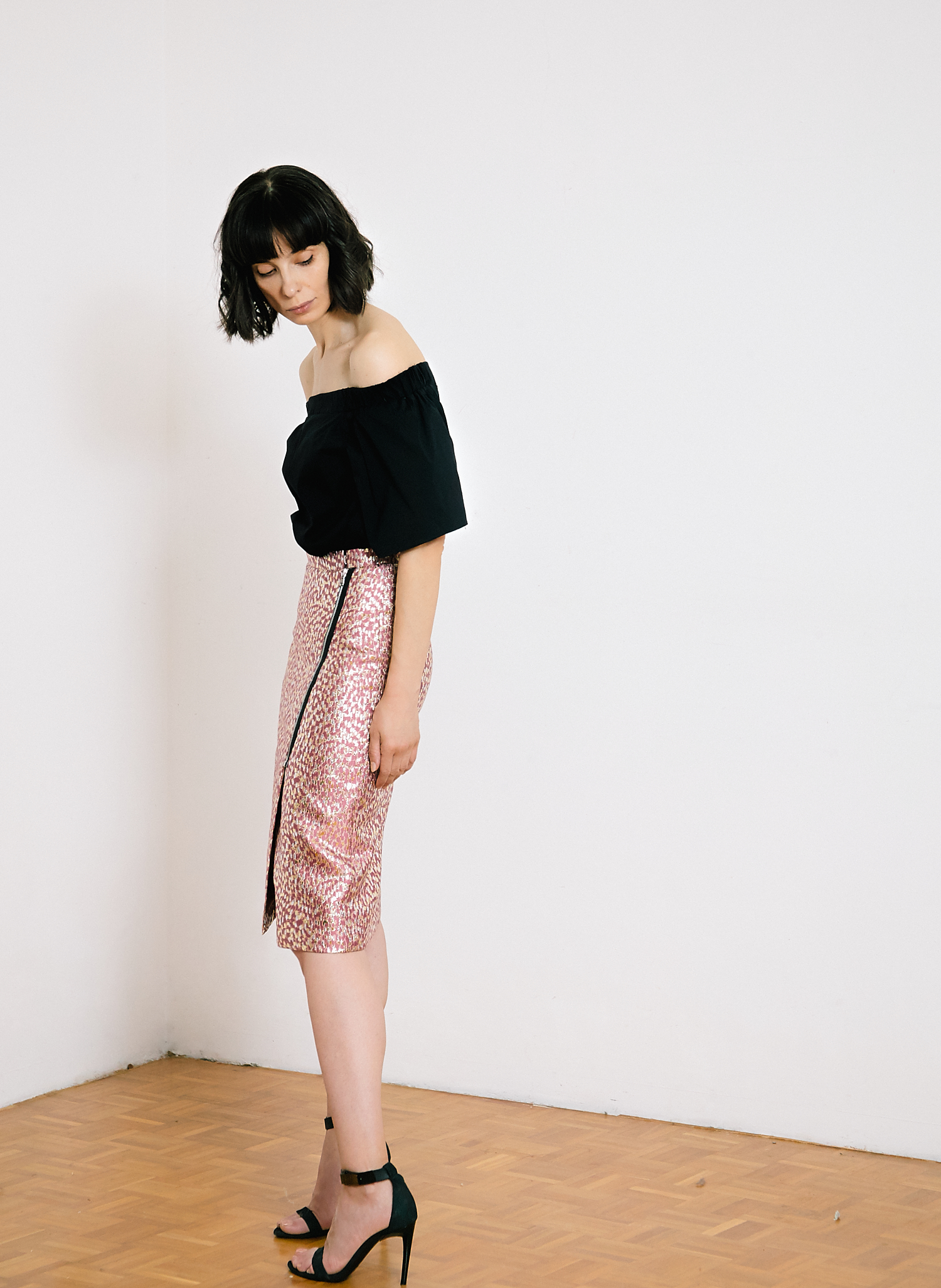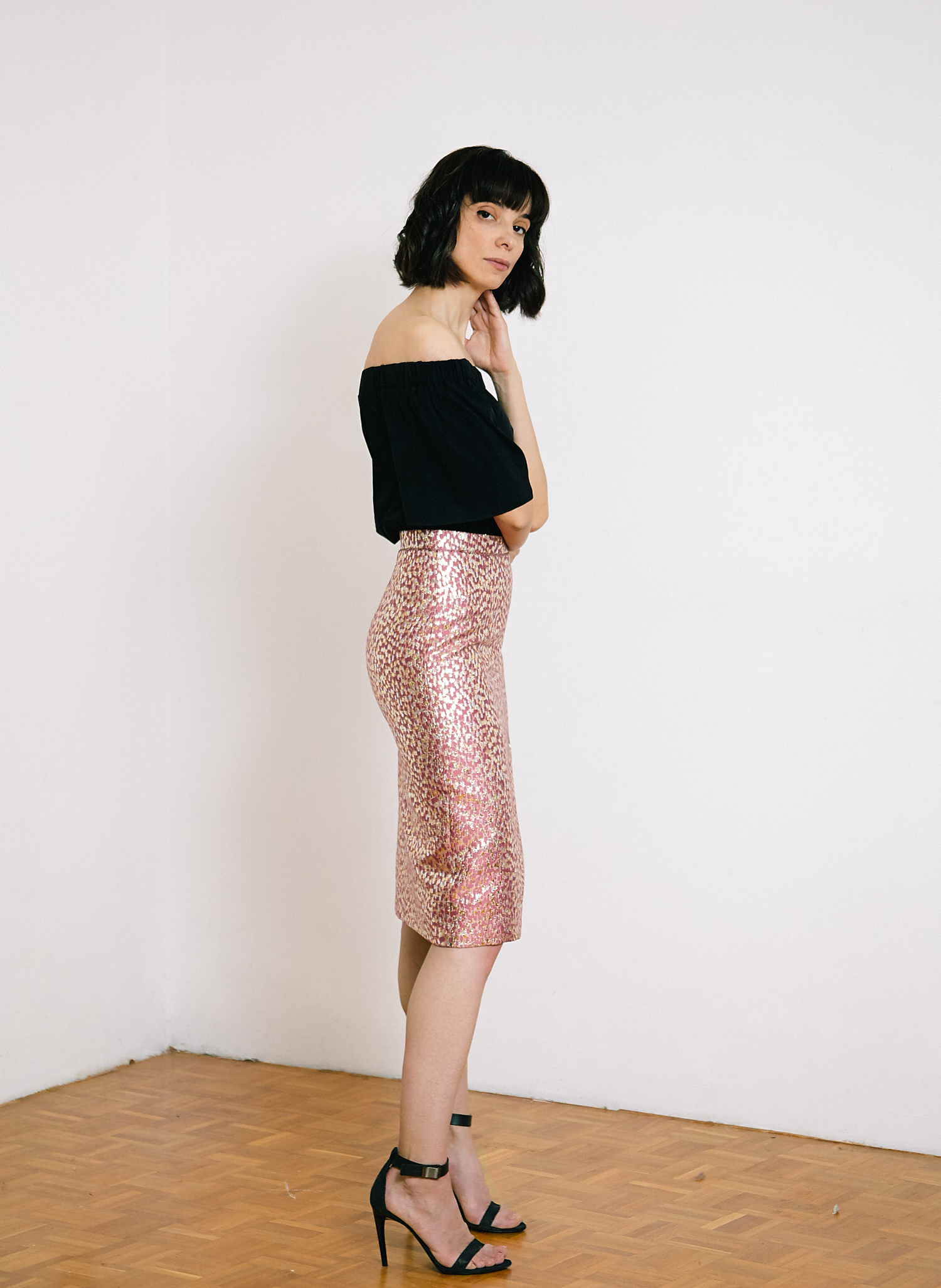::::"Shine bright like a diamond"… may very well be a runway theme song these days. It started slowly around 2014 with shoes and accessories to explode as a major trend in 2017 and go on for next fall in a symphony of sparkle with metallic paillettes, foil, metallic thread jacquards and embroidery, and iridescent fabrics. I mean it's an 80's disco ball! And if there's to be a party I wanna be dressed for it ☺ Thus my encounter with Marcella Romanò in Milan last winter couldn't have come at a better time. Se is a gifted artist and fabric designer and she brought me two pieces of her fabrics to try: the "Watercolor polka dots printed cotton Sangallo lace" (a type of broderie anglaise) and the "Drops metallic thread jacquard"
For my July Burda project, I decided to use the jacquard because I really need some sparkle in my life right now … and pink…-ish.
The fabric being a non-stretch jacquard is very stable - all fabrics with floats are. It also needs lining because the metallic thread as you can imagine it's a bit rough on the skin. I looked for a pattern with a fairly basic cut that would let the fabric shine. Burda Side Zipper Skirt 08/2017 #102 from the Highlights collection seemed to fit the bill. It has a very simple construction, it's a wrap skirt with no vents to worry about, and can easily be lined. Bonus: the zipper detail – paired with the sparkly fabric sort of goes together (in a "collection" kind of way) with the Burda Cropped pants I made a couple of years ago out of a stretch gold lamé designer jacquard. ::
"Shine bright like a diamond"… potrebbe benissimo essere il soundtrack di molte delle ultime passerelle. Tutto è cominciato attorno 2014 con scarpe e accessori per esplodere come tendenza nel 2017 e continuerà nel prossimo autunno-inverno con una sinfonia di paillette metalliche, pelle e tessuti metallizzati, lamé e jacquard lamé e tessuti iridescenti. Insomma manca solo la palla da disco degli anni '80. E se c'è una festa voglio essere vestita per la festa! Dunque, il mio incontro con Marcella Romanò in Milano lo scorso inverno non poteva avvenire in un momento più opportuno. In quell'occasione, Marcella, una talentuosa artista e designer di tessuti mi ha portato due campioni da provare: un sangallo di cotone con stampa "Watercolor pois" e un jacquard lamé "Gocce". Per questo mio progetto Burda per il mese di luglio ho deciso di usare il tessuto jacquard… ho veramente bisogno di un po' di luccichio nella mia vita.
Il tessuto è un jacquard non stretch quindi come tutti i tessuti con fili flottanti è molto stabile. Ha anche bisogno di essere foderato perché il filato metallico sulla pelle non è proprio piacevole. Cercando un cartamodello con un taglio basilare che metta in mostra al meglio il tessuto, ho trovato la Gonna con cerniera laterale Burda 08/2017 #102. Ha una costruzione molto semplice, è una gonna a portafoglio senza spacchi e chiusure "complicati" e può essere foderata facilmente. In più, con la lampo a vista sul tessuto luccicoso, sta bene (nel senso che potrebbero appartenere alla stessa "collezione") con i pantaloni Burda che ho cucito un paio di anni fa in jacquard lamé dorato stretch. ::::
::::[You get indoors pictures because for me these are both "after sunset" garments which is not the best time for quick blog snaps ;) Believe it or not I don't do dress up for photo-shoots … I really don't have the time for it. (I'd rather be sewing) What I usually do is when I know I'll be wearing a garment that is to go up on the blog, I set aside 10-15 minutes before going wherever I need to go, take my camera and my tripod, plant myself somewhere near my house and take a few shots. I then drop camera and tripod home and go on with my day. As you can see from the pictures I publish, this never happens in the morning … in the morning those 10-15 min are precious. If it's raining or there's not enough light to guarantee things are simple I take the pictures inside. The "documentation" photos, the front, side and back pics, I take in my sewing room just after finishing a garment because I think they're useful. This is a sewing blog after all… it's not a fashion blog or a photography blog. It's not about how cute I am (I'm not), and it's not self-celebratory. It's about slow fashion … the slowest kind of fashion. It's about being able to make clothes that are good enough to wear IRL… Wow … where did this rant come from!!! ]
I chose the pattern based on the technical drawing … the pictures don't do much for it. In fact, they show a skirt that's a little loosey-goosey which is a look I don't particularly enjoy in my pencil skirts. I happen to think this sort of skirt looks best when is form fitting. ::
Ho scelto il cartamodello in base al disegno tecnico … non ho trovato le fotografie del capo finito molto attraenti. La gonna fotografata sembra un po' abbondante per i miei gusti. Preferisco le gonne a tubino più attillate che mettono meglio in risalto le forme.::::
::::I have no idea what fabric they used for that sample (the instructions suggest it's a heavier rayon stretch woven) and as I said my fabric has virtually no stretch so to determine the right size to cut I draped the fabric around my hips and measured. To determine where to measure on the pattern the hip circumference, I also measured my hip depth (waist to hip length). Then I measured the pattern and the closest size (included a couple of centimeters extra ease) was a size down from the size I should have cut according to the body measurements charts. ::
Non so che tessuto hanno usato per il loro campione (le istruzioni fanno pensare che sia un tessuto a navetta stretch di viscosa, pesante), e come dicevo, la mia stoffa ha in pratica zero elasticità quindi per determinare la taglia da tagliare ho drappeggiato il tessuto attorno ai miei fianchi e poi ho misurato. Ho misurato anche l'altezza fianchi (lunghezza vita-fianchi) per saper dove misurare la circonferenza fianchi sul cartamodello. Quindi ho misurato il cartamodello e la taglia più vicina alle misure appena prese (più un paio di centimetri extra vestibilità) è risultata la taglia 36 quando seguendo la loro tabella taglie avrei dovuto tagliare una 38. ::::
::::The pattern has definitely too much ease in it and they also used a stretch fabric …. Why?
I didn't bother with measuring the waistline … it can always be adjusted through the darts. I usually determine the length of the waistband by measuring myself not the pattern or the cut line. I would define my body shape as a spoon. It's like a pear with a shelf: my high hip is fuller – just like the spoon head. This means that if I want the skirt (or pants) to stay where it's supposed to stay, anchored to my waist, I need to ease the skirt into the waistband.
This fabric frays like it's trying to disappear, so I had to serger cut it. Basically, I copy the pattern with a marker on the back of the fabric, cut loosely around it and then do the proper cutting with the serger following with the knife the lines that I drew. I used the main pattern to cut the lining. I shortened it by 8cm and trimmed the wrap facings, plus an extra inch.
The sewing went smoothly. I bagged the lining through the waist. ::
Il cartamodello ha, secondo me, troppa vestibilità per il design e in più hanno anche usato un tessuto stretch … Perché?
Non mi sono preoccupata di misurare la circonferenza vita… può sempre essere aggiusta usando le pince. Solitamente determino la lunghezza del cinturino misurando me stessa non il cartamodello o la linea di taglio dove andrà a inserirsi. Definirei la mia corporatura "a cucchiaio" con i fianchi che si allargano bruscamente (come la coppa del cucchiaio). Vuol dire che se voglio che il cinturino stia ancorato alla vita devo molleggiare la gonna (o i pantaloni) nel cinturino.
Questo tessuto si sfilaccia come se volesse scomparire, quindi l'ho tagliato con la tagliacuci. Ho copiato il cartamodello sul retro della stoffa con un marker, ho tagliato abbondantemente attorno e poi ho tagliato propriamente seguendo con il coltello della tagliacuci la linea di taglio disegnata. Usando lo stesso cartamodello ho tagliato anche la fodera. L'ho accorciata di 8 cm (per l'orlo) e ho eliminato anche il ripiego più extra 2,5cm così che non sia visibile nell'incoccio.
Il confezionamento è filato liscio. Ho completamente rinchiuso la fodera. ::::
::::Looking at the pattern pictures I also noticed that maybe the zipper is a tad too short cause it hits in a place where it causes a lot of draglines, so I first basted it and tried it on.
To make the skirt hang nicely I also weighted it by inserting chain in the hem. ::
Guardando le foto del modello ho notato che forse la cerniera e troppo corta e crea delle linee di tensione non molto carine. Per capire che lunghezza dovevo farla per evitare la formazione di queste linee l'ho prima imbastita e l'ho provata. Per dare un po' di peso e tenuta alla gonna ho inserito della catena nel orlo.::::
::::Pattern: Side Zipper Skirt 08/2017 #102 by Burda
Fabric: jacquard (75%PL 25%PM) from Marcella Romanò
Size: 36 (ref. measurements 177/84/68/94 cm)
Fitting : waistline skirt +1,5 cm eased into waistband
Mods: lengthened zipper, lining
::Modello: Gonna con cerniera laterale di Burda
Tessuto: jacquard (75%PL 25%PM) di Marcella Romanò
Taglia: 36 (mis. di riferimento 177/84/68/94 cm)
Adattamento : lunghezza vita +1,5cm molleggiata nel cinturino
Modifiche: allungata la cerniera, fodera::::
::::I'm really pleased with this skirt and it actually took me longer writing this than sewing it. It's really easy to sew, especially if the fabric you use doesn't require a lining. ::
Questo è quanto. Sono molto contenta del risultato. Per dire la verità mi ci è voluto più tempo per scrivere e pubblicare questo articolo di quanto c'ho messo per fare la gonna che è molto facile da cucire, specialmente se si usa un tessuto che non richiede fodera. ::::
::::Thank you for visiting. I would love to hear your opinion and if you like it put a <3 on it!:: Grazie della visita. Mi piacerebbe moltissimo sentire la tua opinione e se questo post ti piace mettici un <3!::::













